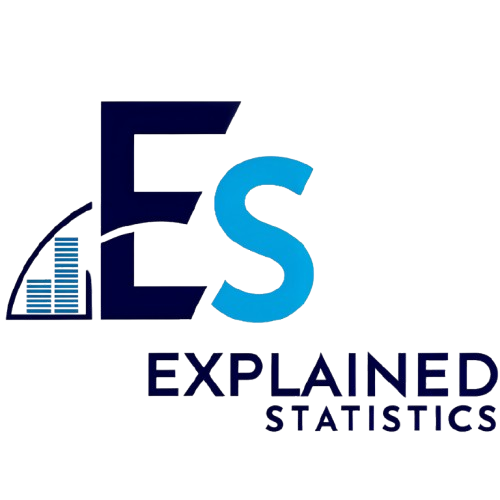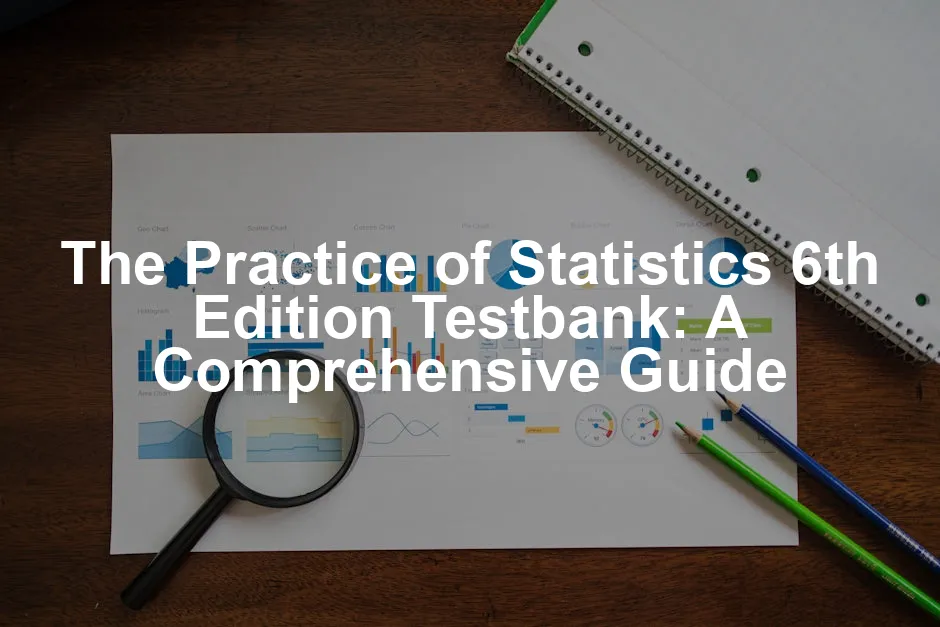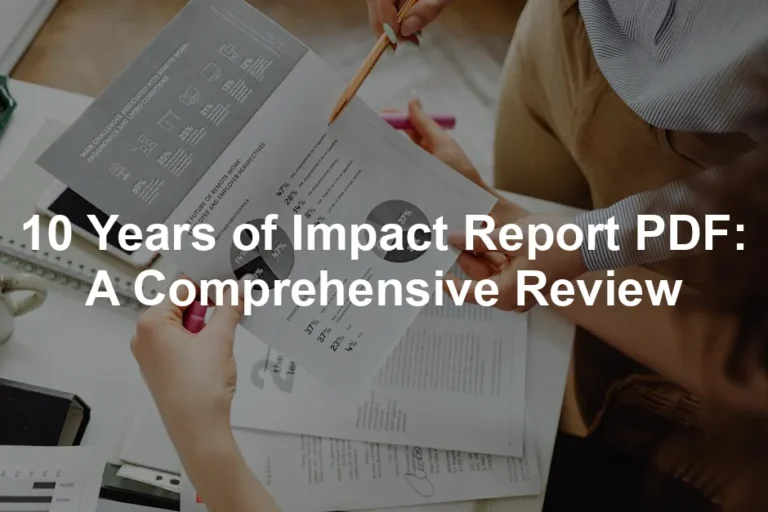Introduction
Statistics isn’t just about numbers; it’s about making sense of the world! For AP Statistics students and educators, “The Practice of Statistics” 6th edition is a trusted ally. This textbook serves as a roadmap, guiding learners through the complexities of statistics with clarity and humor.
So why is this edition a must-have? First, it aligns perfectly with the AP curriculum. Students can tackle real-world problems using statistical tools, preparing them for exams and future endeavors. Educators also find it invaluable. The textbook provides a wealth of resources, making lesson planning a breeze.
Now, let’s talk about the test bank. This treasure trove of questions is essential for effective teaching and assessment. It’s not just a bunch of questions thrown together; it’s a carefully crafted collection designed to reinforce learning. Each question aligns with the textbook, ensuring that students are tested on what they’ve learned.
Imagine walking into a classroom where every student feels prepared. The test bank helps create that environment. It offers a mix of question types—multiple choice, free-response, and more—catering to different learning styles. This variety not only keeps students engaged but also helps them retain information better.
In essence, the 6th edition of “The Practice of Statistics” and its accompanying test bank are like peanut butter and jelly—they just work well together! They empower both students and teachers, making the complex world of statistics accessible and enjoyable.

Understanding the Practice of Statistics 6th Edition
Let’s take a closer look at this textbook. Authored by the dynamic duo, Daren Starnes and Josh Tabor, this edition is structured to enhance understanding and application of statistical concepts.
The book is divided into clear units, each focusing on different aspects of statistics. From data analysis to probability, each chapter builds on the last, creating a logical flow that’s easy to follow. For example, the first unit dives into data analysis, teaching students how to interpret and visualize data effectively.
Furthermore, the textbook is rich in examples. Each concept is paired with real-world applications, making statistics relatable. Students can see how the abstract ideas they learn translate into actionable insights.
Technology integration is another highlight. The authors understand that calculators and software play a big role in today’s learning environment. Instructions for using tools like the TI-84 Plus CE Graphing Calculator are included, allowing students to apply their knowledge practically.
In short, “The Practice of Statistics” 6th edition is a comprehensive resource that is not only educational but also engaging. With its structured layout, real-world examples, and technological support, it’s designed to foster a deeper understanding of statistics for students at all levels.

Authors and Their Expertise
Daren Starnes and Josh Tabor are not just authors; they are seasoned educators with a passion for teaching statistics. Daren, the Mathematics Department Chair at The Lawrenceville School, has over 25 years of experience. His expertise shines through in every chapter, making complex concepts accessible.
Josh, too, brings a wealth of knowledge. With over 23 years in the classroom, he has a knack for engaging students. His experience as a finalist for Arizona Teacher of the Year speaks volumes about his dedication to education. Together, they’ve created a textbook that resonates with both students and educators.
Their backgrounds include leading AP Statistics workshops and contributing to educational committees. This involvement ensures that their content is not only relevant but also aligned with current educational standards.
In essence, Starnes and Tabor are the perfect pair to guide students through the maze of statistics. Their combined expertise and commitment to education make “The Practice of Statistics” a top choice for AP Statistics courses.

Key Features of the Textbook
What makes the 6th edition stand out? Let’s break it down. First, the textbook employs innovative pedagogical strategies. Each chapter begins with clear objectives, helping students understand what they are expected to learn.
Next, the organization is intuitive. Chapters progress logically, making it easy for students to follow. For instance, after mastering data analysis, students move on to modeling distributions—building on what they’ve already learned.
Another key feature is the integration of technology. The book includes detailed instructions for using calculators and software, ensuring students can apply their knowledge in real-world scenarios. This is crucial in today’s data-driven world!
Moreover, the test bank is revised extensively. It offers a treasure trove of questions that align perfectly with the textbook material. This alignment is critical for effective assessment, allowing educators to gauge student understanding accurately.
Finally, the textbook emphasizes collaborative learning. Built-in activities and projects encourage students to work together, fostering a deeper engagement with statistical concepts.
In summary, the 6th edition of “The Practice of Statistics” is a comprehensive, user-friendly resource that combines effective teaching strategies, technology integration, and a wealth of assessment tools. It’s designed to empower students and educators alike, making statistics a subject to be embraced rather than feared.

The Test Bank: An Invaluable Resource
A test bank is like a treasure chest filled with questions. For educators, it’s a goldmine for crafting assessments. For students, it’s a way to gauge understanding and prepare for exams. The “Practice of Statistics” 6th edition test bank embodies all these benefits and more.
Why is a test bank so crucial? Well, imagine teaching a class where every student has a unique learning style. Some thrive on multiple-choice questions, while others prefer free-response formats. The test bank caters to both! It provides a variety of question types that align directly with the textbook material. This alignment ensures that assessments are relevant and reflective of what students have learned.
Moreover, using a test bank promotes consistency. Educators can maintain a steady pace in assessments, ensuring that all topics are covered. This not only helps in tracking student progress but also prepares students for standardized tests, like the AP exam. No more guessing what might be on the test! Each question pulls from the core concepts taught in class, making it a reliable study tool.
Let’s not overlook the time-saving aspect. Crafting quality assessments can be time-consuming. The test bank alleviates this burden. Educators can select pre-made questions instead of starting from scratch. This efficiency allows teachers to focus on what truly matters—teaching!
Additionally, the test bank fosters a culture of collaboration. Educators can share insights and strategies about effective questions. This exchange of ideas can lead to improved teaching methods and better student outcomes. When teachers work together, they create a richer learning environment.
In short, the test bank for the “Practice of Statistics” 6th edition is an invaluable resource. It empowers educators with diverse assessment tools and helps students prepare effectively. With this resource at their disposal, both teachers and students can navigate the complexities of statistics with confidence and ease. The journey through statistical concepts becomes not just manageable, but an engaging adventure!

Components of the Test Bank
The test bank for the “Practice of Statistics” 6th edition is thoughtfully designed to support educators and students alike. It features a variety of question types, ensuring that assessments are comprehensive and engaging.
First up, we have multiple-choice questions. These questions assess students’ knowledge quickly and efficiently. They can cover a range of topics, from basic definitions to more complex applications. This format is great for quick quizzes or practice tests, allowing students to test their understanding in a low-pressure environment.
Next, we dive into free-response questions. These require students to articulate their reasoning and demonstrate their problem-solving skills. Free-response questions are essential for fostering critical thinking. They encourage students to explain their thought processes, making them ideal for deeper learning.
Short answer questions also feature prominently in the test bank. These questions strike a balance between multiple-choice and free-response. They allow students to provide concise answers while still requiring them to engage with the material meaningfully.
In addition to these formats, the test bank includes case studies and real-world scenarios. These questions challenge students to apply what they’ve learned in practical contexts. They bridge the gap between theory and application, making statistics relevant to everyday life.
Moreover, the alignment of these questions with the textbook material is paramount. Each question corresponds to the chapters and key concepts outlined in the “Practice of Statistics”. This ensures that students are tested on what they’ve been taught, reinforcing their learning and preparing them for future assessments.
Additionally, the test bank is regularly updated. This means it reflects the latest changes in educational standards and practices, ensuring that both students and educators are on the cutting edge.
Lastly, the test bank promotes inclusive education. With a variety of question types, it caters to diverse learning styles. Whether a student excels in analytical thinking or struggles with written expression, the test bank’s range of questions provides every learner with an opportunity to shine.
Utilizing this comprehensive test bank allows educators to create effective assessments that align perfectly with their teaching goals. It enhances the overall educational experience by providing multiple avenues for students to demonstrate their understanding of statistics.

Utilizing the Test Bank for Effective Assessment
Integrating the test bank into lesson plans can be a game-changer for educators. Here are some practical tips and strategies for maximizing its potential.
Start with planning. Before the semester kicks off, review the test bank. Familiarize yourself with the types of questions available. Identify which sections of the test bank align with your curriculum. This preparation sets a solid foundation for the assessments you’ll create.
Next, use the test bank to create a variety of assessments. Mix multiple-choice questions with free-response ones. This balance keeps students engaged and allows for different types of skill demonstration. Consider incorporating short answer questions to add variety to quizzes and tests.
Don’t forget about formative assessments! Use questions from the test bank for low-stakes quizzes. These assessments provide immediate feedback and help identify areas where students may struggle. Regular check-ins keep students motivated and informed about their progress.
In addition, consider the pacing of assessments. Spread out the questioning over multiple classes. For example, use a few questions from the test bank during class discussions. This approach reinforces learning and allows for real-time feedback.
Collaboration is key! Share the test bank with colleagues. Discuss which questions worked well and which didn’t. This collaborative effort can lead to improved assessments and better student outcomes. Plus, it fosters a supportive teaching community.
Encourage students to use the test bank for self-study. Provide them with access to practice questions. This empowers them to take charge of their learning. They can assess their understanding and identify areas to focus on before exams.
Lastly, adapt assessments based on student performance. If a significant number of students struggle with a particular concept, consider revisiting it in class. Use the test bank to adjust future assessments, ensuring they align with what students need to learn.
In summary, utilizing the test bank effectively enhances the assessment process. It allows educators to create diverse, engaging, and relevant assessments. By integrating this resource into lesson plans, teachers can foster a deeper understanding of statistics among their students, paving the way for academic success.

Chapter 1: Data Analysis
In the realm of statistics, data analysis is the starting point for all statistical exploration. Chapter 1 of “The Practice of Statistics” 6th edition lays the groundwork for understanding how to analyze categorical data effectively. Categorical data refers to variables that can be divided into different categories, such as colors or types of fruit. The chapter teaches students to summarize and visualize these data types through tables and bar graphs, making it easy to spot trends and patterns.
Next, we dive into displaying quantitative data. Here, students learn to use a variety of graphs, including histograms and box plots. These visual tools allow for a more profound understanding of data distribution, highlighting measures like central tendency and variability. Imagine trying to understand a dataset of student test scores—without these visuals, it’s like trying to navigate a maze blindfolded!
Describing quantitative data is all about numbers. The chapter emphasizes key descriptive statistics, including mean, median, mode, and standard deviation. By the end of this chapter, students will feel equipped to present and interpret data confidently. This knowledge is critical for making informed decisions based on statistical evidence, whether in a classroom, business, or research setting.
For those who want to dive deeper into statistical concepts, consider picking up Statistics for Dummies. It breaks down complex topics into easy-to-understand language, making it perfect for anyone who feels a little lost in the numbers.

Chapter 2: Modeling Distributions of Data
Chapter 2 introduces the concept of modeling distributions of data. This chapter is essential for understanding how data behaves and what it means in the broader context. Density curves take center stage as students learn to visualize the distribution of a dataset. These curves help us grasp concepts like shape, center, and spread, providing a clear picture of the data trends.
Normal distributions are a key focus in this chapter. With their characteristic bell shape, normal distributions are everywhere in statistics. Students discover how to identify and interpret these distributions, which is crucial for hypothesis testing and inferential statistics. The chapter emphasizes the significance of the empirical rule, which states that about 68% of data falls within one standard deviation of the mean. This rule is not just a statistician’s trivia; it’s a powerful tool for making predictions about data.
Moreover, the chapter explores real-world applications of these concepts. From evaluating test scores to assessing heights, understanding distributions helps students make sense of everyday phenomena. By the end of this chapter, students will see that statistics isn’t just a collection of numbers—it’s a language that describes the world around us.
If you’re curious about how to effectively communicate data, check out The Visual Display of Quantitative Information. Tufte’s work is a must-read for anyone looking to present data effectively.

Chapter 3: Describing Relationships
Chapter 3 shifts gears, focusing on describing relationships between variables. Here, scatterplots come into play. These graphs provide a visual representation of the relationship between two quantitative variables. Students learn to spot patterns, trends, and even outliers that can provide insights into the data. This is where the magic happens; a quick glance at a scatterplot can reveal whether two variables are positively correlated, negatively correlated, or not correlated at all.
Next up is correlation. This section introduces the correlation coefficient, a numerical value that quantifies the degree to which two variables are related. A perfect positive correlation of +1 indicates that as one variable increases, so does the other. Conversely, a correlation of -1 means that as one variable increases, the other decreases. Understanding these relationships can change the way students interpret data, providing them with tools to make predictions and informed decisions.
Finally, the chapter covers least-squares regression. This powerful technique allows students to create a linear model that best fits the data. They learn how to calculate the line of best fit, which can be used for making predictions. By the end of this chapter, students will appreciate how statistics can illuminate relationships in data, turning raw numbers into meaningful stories.
If you’re looking for a more visual and humorous approach to statistics, consider The Cartoon Guide to Statistics. It’s a fun way to grasp complex concepts!

Additional Chapters
Continuing through the textbook, the subsequent chapters delve into essential statistical concepts crucial for mastering AP Statistics.
Chapter 4 focuses on collecting data, emphasizing sampling methods and survey design to ensure reliability and validity. Understanding how to collect data properly sets the stage for accurate analysis.
Chapter 5 introduces probability, exploring the fundamental principles that govern random events and their outcomes. Students learn how to calculate probabilities and apply them to real-world situations.
Chapter 6 covers random variables, distinguishing between discrete and continuous types. This chapter highlights important concepts like expected value and variance, reinforcing their importance in statistical modeling.
In Chapter 7, students explore sampling distributions, learning how sample sizes affect variability and the central limit theorem. These concepts are vital for understanding inferential statistics.
Chapter 8 discusses estimating with confidence, explaining confidence intervals and their applications in estimating population parameters. This chapter helps students gauge how well their sample represents the population.
Chapter 9 dives into hypothesis testing, where students learn to formulate and test claims about population parameters. This chapter is packed with practical examples, reinforcing the relevance of statistical testing.
In Chapter 10, students learn to compare two populations or treatments, exploring techniques for analyzing differences in means and proportions. This is essential for making informed decisions based on comparative data.
Chapter 11 covers inference for categorical data, focusing on chi-square tests and their applications. Students learn to analyze and interpret categorical data effectively.
Finally, Chapter 12 wraps up the textbook by discussing advanced regression analysis, including inference for linear regression. This chapter emphasizes the importance of understanding relationships and making predictions based on data.
By the end of the textbook, students will have a well-rounded understanding of statistics, equipping them to tackle real-world problems with confidence and skill.

Advantages of Using the 6th Edition Test Bank
The “Practice of Statistics” 6th edition test bank is like a Swiss Army knife for both students and educators. It’s multifunctional, versatile, and designed to tackle various educational challenges. So, what are the golden nuggets of benefits hidden within this treasure trove of questions?
To start, it provides an efficient study tool. Students can find a plethora of questions that mirror the textbook content. This alignment helps reinforce learning while preparing them for exams. Nothing beats a good practice session, right? Imagine being able to quiz yourself on what you just learned—it’s like a mini-review session at your fingertips!
For educators, the test bank is a time-saver. Crafting assessments from scratch can be daunting. With a ready-made collection of questions, teachers can focus on what truly matters—engaging with students. They can easily select questions that align with their lesson plans, ensuring that assessments are relevant and reflective of the material covered.
Another significant advantage is the variety of question types. The test bank offers multiple-choice questions, free-response questions, and even short answer formats. This variety caters to different learning styles and helps maintain student interest. Some students thrive on multiple-choice, while others prefer the challenge of free-response. Everyone gets a chance to shine!
Moreover, utilizing the test bank fosters a sense of accountability. Students are more likely to take their studies seriously when they have access to practice questions. It encourages them to engage with the material actively. They can test their understanding and identify areas needing improvement.
The test bank also promotes collaboration among educators. Teachers can share insights about effective questions, discuss what works, and swap strategies. This collaboration enriches the teaching community and enhances the overall educational experience. When educators unite, students benefit!
Finally, the test bank contributes to a consistent assessment strategy. By using questions from the test bank, educators can ensure that all key concepts are covered systematically. This consistency not only helps track student progress but also prepares them for standardized tests, like the AP exam.
In summary, the advantages of using the 6th edition test bank are plentiful. It supports efficient studying, saves educators time, accommodates various learning styles, fosters accountability, facilitates collaboration, and promotes consistent assessment. With such a robust resource at their disposal, students and teachers can navigate the world of statistics with confidence and ease.

Improving Student Outcomes
Utilizing the 6th edition test bank can significantly enhance student outcomes. How, you ask? Let’s break it down. First and foremost, practice makes perfect. The more students engage with the material, the better they grasp statistical concepts. The test bank provides a wealth of practice questions that reinforce learning.
Students can work through questions at their own pace. This allows them to identify their strengths and weaknesses. By pinpointing areas where they struggle, they can focus their efforts on improvement. It’s like having a personal trainer for statistics—tailored workouts just for you!
Additionally, consistent practice leads to better retention. When students encounter questions repeatedly, they’re more likely to remember the concepts. It’s all about repetition! The test bank ensures that students revisit key ideas, making them stick like peanut butter on toast.
Furthermore, the immediate feedback provided by the test bank is invaluable. After completing practice questions, students can check their answers and understand where they went wrong. This instant feedback loop helps them learn from their mistakes. They can adjust their study strategies accordingly.
Incorporating test bank questions into study routines also builds confidence. As students practice and see improvement, they feel more prepared for exams. Confidence is key! A student who believes in their abilities is more likely to perform well.
Lastly, this resource encourages a proactive approach to learning. Instead of waiting until the last minute to study, students can integrate practice questions into their regular study habits. This shift promotes a deeper understanding of statistics.
In essence, utilizing the 6th edition test bank enhances student outcomes through consistent practice, improved retention, immediate feedback, increased confidence, and proactive learning strategies. It’s a win-win for everyone involved in the statistical journey.

Supporting Diverse Learning Styles
Every student learns differently. Some are visual learners, while others thrive on hands-on activities. The 6th edition test bank recognizes this diversity and caters to various learning preferences. Let’s take a closer look at how it supports diverse learning styles.
First, the variety of question types is a game changer. The test bank features multiple-choice questions, free-response, and short answer formats. This range allows students to engage with the material in ways that suit their learning styles. Visual learners can benefit from graph-based questions, while analytical thinkers may excel with free-response problems that require deeper reasoning.
Moreover, the test bank encourages active engagement. Students who prefer kinesthetic learning can create their own practice sessions. They can simulate exam conditions, timing themselves as they answer questions. This hands-on approach helps solidify concepts while keeping learning dynamic and exciting.
Another way the test bank supports diverse learning styles is through collaboration. Group study sessions can revolve around the test bank questions, allowing students to learn from one another. They can discuss different approaches to solving problems, share insights, and clarify misunderstandings. This collaborative learning environment fosters a sense of community and enhances understanding.
Additionally, the test bank encourages self-directed learning. Students can choose which questions to tackle based on their comfort level. Those who feel confident might jump straight to challenging questions, while others can start with easier ones. This autonomy in learning empowers students to take charge of their education.
Furthermore, educators can use the test bank to design inclusive assessments. By selecting a range of question types, teachers can ensure that all students have the opportunity to demonstrate their understanding. This inclusivity fosters a sense of belonging and encourages every student to participate.
In conclusion, the 6th edition test bank supports diverse learning styles through a variety of question formats, active engagement opportunities, collaborative learning, self-directed study, and inclusive assessments. With this resource, every student can find a path to success in understanding statistics.

Conclusion
In conclusion, the “Practice of Statistics” 6th edition and its comprehensive test bank stand as vital resources in the educational sphere. This powerful duo provides students and educators with the tools needed to conquer the challenges of AP Statistics. The textbook, authored by the experienced Daren Starnes and Josh Tabor, aligns perfectly with the AP curriculum, offering a structured approach to learning.
The test bank, a well-crafted compilation of questions, is not just a collection of assessments; it’s a strategic companion that enhances the learning experience. It features a diverse array of question types, catering to different learning styles. Whether students prefer multiple-choice questions that test their quick recall or free-response questions that challenge their critical thinking, the test bank has it all. This variety helps keep students engaged and motivated.
Moreover, the alignment of the test bank with the textbook material ensures that assessments are relevant and meaningful. Educators can confidently utilize these questions to gauge student understanding, knowing they reflect the core concepts taught in class. This consistency promotes a more effective learning environment, where students can focus on mastering statistical concepts rather than guessing what might appear on an exam.
Additionally, the 6th edition of “Practice of Statistics” goes beyond mere numbers. It incorporates real-world examples, technology integration, and innovative teaching strategies. This multifaceted approach helps demystify statistics, making it accessible and enjoyable for students. The emphasis on data analysis, probability, and statistical argumentation equips students with skills they can apply in their academic and professional futures.
Ultimately, the “Practice of Statistics” 6th edition and its test bank are indispensable for anyone navigating the complexities of statistics. They empower both students and teachers, transforming what could be a daunting subject into an engaging adventure. With these resources at their fingertips, students can approach their studies with confidence, ready to tackle any statistical challenge that comes their way.

FAQs
What is included in the test bank for the 6th edition?
The test bank for the “Practice of Statistics” 6th edition includes a variety of question types, such as multiple-choice, free-response, and short answer questions. These questions cover all chapters of the textbook, ensuring comprehensive assessment opportunities that align with the material taught.
How can I access the test bank?
Teachers can access the test bank through educational platforms associated with the textbook, such as the publisher’s website or educational resource portals. Schools often provide access codes for teachers, making it easier to incorporate the test bank into lesson plans.
Are there any additional resources available for teachers?
Yes, along with the test bank, the “Practice of Statistics” 6th edition offers an extensive range of resources for educators. These include online homework programs, instructional videos, and a Teacher’s Edition that provides additional guidance and support for reinforcing key concepts in the classroom.
What are the main updates in the 6th edition compared to previous editions?
The 6th edition features a restructured organization that aligns with the 2019-2020 AP Statistics Course Framework. Key updates include enhanced problem sets, integrated technology support, and a more robust test bank. Additionally, it incorporates collaborative learning activities, making statistics more engaging for students.
Please let us know what you think about our content by leaving a comment down below!
Thank you for reading till here 🙂
For more information on the AP Statistics formula sheet, check out this comprehensive guide.
All images from Pexels




